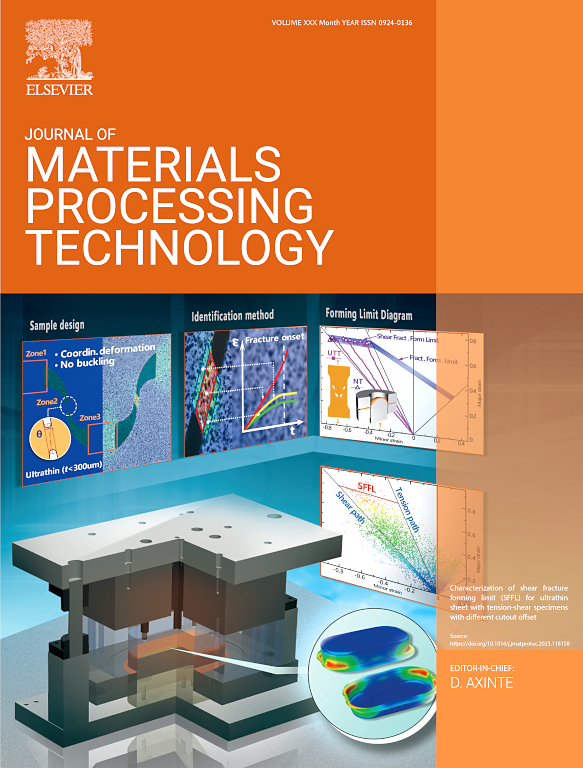Mechanisms of strain rate effect on pure Ti deformation: Application in the bipolar plates forming process
IF 6.7
2区 材料科学
Q1 ENGINEERING, INDUSTRIAL
Journal of Materials Processing Technology
Pub Date : 2025-06-10
DOI:10.1016/j.jmatprotec.2025.118933
引用次数: 0
Abstract
In the present research, the mechanical behavior of pure Ti was analyzed at room temperature under low strain rates (LSRs, 0.001 s−1, 0.01 s−1 and 0.1 s−1) and high strain rates (HSRs, 1160 s−1, 1670 s−1 and 2310 s−1). The results demonstrated that as the strain rate increased from 0.001 s−1 to 2310 s−1, the elongation increased significantly by 27 %. The underlying mechanisms governing the strain rate dependence of plasticity were elucidated through microstructural analysis. The frequency of deformation twinning increased notably with strain rate. This effect was especially obvious during the transition from LSR to HSR. Deformation twinning inhibited dislocation motion and enhanced the work hardening capacity. Simultaneously, hard oriented grains (HOG) were found to play a significant role in the plastic deformation under HSR loading, enhancing the deformation coordination between grains and improving material deformation uniformity. This improvement in deformation uniformity mitigated premature localized strain and necking. Further, based on the plasticity-strengthening mechanism induced by HSR loading, an electro-hydraulic forming (EHF) method for the fabrication of pure titanium bipolar plates (Ti-BPPs) at room temperature. In comparison to the conventional LSR loading rubber pad forming (RPF) method, the EHF process significantly improved formability and addressed manufacturing challenges associated with pure Ti-BPPs. The proposed method successfully achieved the formation of complete flow channels with dimensional accuracy within a ± 10 μm tolerance. Additionally, the average thickness reduction in corner regions decreased from 34.2 % to 15.7 %. These findings provide theoretical insights that could guide the manufacturing of pure Ti-BPPs with thin walls and small structural sizes in industrial application.
应变率对纯钛变形的影响机制:在双极板成形过程中的应用
在本研究中,分析了纯Ti在室温下低应变率(LSRs, 0.001 s−1,0.01 s−1和0.1 s−1)和高应变率(HSRs, 1160 s−1,1670 s−1和2310 s−1)下的力学行为。结果表明,当应变速率从0.001 s−1增加到2310 s−1时,伸长率显著提高了27 %。通过显微组织分析,阐明了塑性依赖于应变速率的潜在机制。变形孪晶的发生频率随应变速率的增加而显著增加。这种效应在低铁向高铁过渡期间尤为明显。变形孪晶抑制位错运动,提高加工硬化能力。同时,发现硬取向晶粒(HOG)在高铁加载下的塑性变形中发挥了重要作用,增强了晶粒之间的变形协调性,提高了材料的变形均匀性。这种变形均匀性的改善减轻了过早的局部应变和颈缩。此外,基于高铁加载诱导的塑性强化机制,采用电液成形(EHF)法制备了纯钛双极板(Ti-BPPs)。与传统的LSR加载橡胶垫成形(RPF)方法相比,EHF工艺显著提高了成形性,并解决了与纯ti - bpp相关的制造挑战。该方法成功地实现了完整流道的形成,尺寸精度在 ± 10 μm的公差范围内。此外,转角区域的平均厚度减少从34.2% %下降到15.7% %。这些发现为工业应用中薄壁小尺寸纯Ti-BPPs的制造提供了理论指导。
本文章由计算机程序翻译,如有差异,请以英文原文为准。
求助全文
约1分钟内获得全文
求助全文
来源期刊

Journal of Materials Processing Technology
工程技术-材料科学:综合
CiteScore
12.60
自引率
4.80%
发文量
403
审稿时长
29 days
期刊介绍:
The Journal of Materials Processing Technology covers the processing techniques used in manufacturing components from metals and other materials. The journal aims to publish full research papers of original, significant and rigorous work and so to contribute to increased production efficiency and improved component performance.
Areas of interest to the journal include:
• Casting, forming and machining
• Additive processing and joining technologies
• The evolution of material properties under the specific conditions met in manufacturing processes
• Surface engineering when it relates specifically to a manufacturing process
• Design and behavior of equipment and tools.
 求助内容:
求助内容: 应助结果提醒方式:
应助结果提醒方式:


